Achievements
THE LEACHING CHARACTERISTICS OF FLUORIDE IN SOILS AND ROCKS AND THEIR INFLUENCE ON GROUNDWATER IN YANCHI, CHINA
Han Zhantao, Zhang Fawang, Gui Jianye,
Zhang Xiangyang, Chen Li, Cui Xiaomei
Institute of Hydrogeology and
Environmental Geology, Chinese Academy of Geosciences, Shijiazhuang,
050061, China
Abstract:Systematic
investigations of the fluoride content in soils, rocks and groundwater, and
leaching experiments on soils and rocks were carried out in Yanchi area,
Ningxia Hui autonomous region of China. The results show that: the average
fluorine content in groundwater of this area is 4.3mgl-1, much higher
than the national drinking water standard (1mgl-1); The total
fluoride in Quarternary deposits are similar with the nationwide median value,
but the water soluble fluoride are much higher than that of low fluoride area,
such as Zhejiang province, this is one of the main reasons for the high value
of fluoride content in this area. Among the F-bearing minerals, only mica
is abundant in some samples, and the fluoride in it can be leached out to some
extent. All the soil samples are alkalescent, the pH of these samples is around
8.07~10.05, that
provided a perfect environment for the activate and migration of fluoride. Tertiary
stratum is a significant factor influencing the F content of research area, for
it’s ubiquitously distributed, and has high TF value and LF value. For lots of
factors can influence the fluoride content of groundwater, the relationship
between the LF and WF of soil and the fluoride content of groundwater related
with the soil is not distinct, but obviously the overall high values of TF, WF
and LF is a key factor of the formation of high fluoride groundwater.
Keywords:Yanchi area; soil
and rock; groundwater; Fluoride; Leaching characteristics;
1 Introduction
Fluorosis is one
of the main endemics in the world, it main caused by overtaken of fluoride,
groundwater is the main source of human intake of fluorine. In China,
fluorosis is caused by several fluoride sources, including high fluoride
groundwater, high fluoride coal and clay (Baoshan Zheng et al. 2005; Lisheng
Yang. 2003), and high fluoride brick tea (Wang and Huang. 2000). Among them,
shallow high-fluoride groundwater is the most prevalent, exists in the vast
arid and semi-arid regions of north China, includes the west of northeast
plain, the north China plain, the arid basins in northwest, and the salt lakes
in Tibetan autonomous region, roughly like a broad band from east to west in
the north of China. (Changhan Liu. 1988), this result in that fluoride poisoning
is the most widespread and serious endemic disease in the inland river basins
of north-westChina (Wang Zhenxu, et al. 2001).
In the vast
high-fluoride groundwater band in north China, arid climate, stagnant
groundwater flow, and the alkaline geochemical environment, are the three main
reasons for the formation of high-fluoride groundwater (Changhan Liu. 1988;
Baoshan Zheng. 1992; Wang Zhenxu, et al. 2001). Except for these factors, the
water soluble salt content and mineral composition of stratum assemblage is
also an important factor (Wang Zhenxu, et al. 2001).
Even with a
sizeable atmospheric source, the mobility of the F- should,
once it is deposited, be governed by the soil and rock conditions ( Gunnar
Jacks et al. 2005). Water/rock interactions (includes dissolution/
precipitation, adsorption/ desorption, and dilution/ condensation) are the
direct influencing process of above mentioned factors on the fluoride content
of groundwater.
During the
infiltration of rainwater, the water-soluble salts, including the water-soluble
fluoride, will dissolve into water, and migrate downward, during the migration,
the chemical composition of water will change with the dissolve/precipitation
of minerals, and adsorption/desorption of ions( Junyao Yang. 2000), leaching
process which is composed by dissolution and desorption, is the direct
causation for the accruement of fluoride in groundwater (Wuyi Wang, et al.
2002).
Yanchi county
located in the middle area of the high fluoride groundwater band of north
China, the F content in the groundwater of Yanchi county is about 0.9~25mgl-1 , the average F
content is 4.9 mgl-1, much higher than its surrounding areas.
“Yanchi” means salt pond, for there are several little salt lakes in this
county. Salt lake is a significant sign of the intense evaporation, and
accumulation of soluble salts, obviously F will also accumulate in the lake
basins, and lead to the high level of F content in groundwater.
But high F
groundwater exists not only in the salt lake basins- the condensing areas, but
also in the surrounding hill areas- the recharging areas, maybe it’s not only
the arid climate, but the high F content of the aeration zone and aquifer also
lead to the high F content of groundwater.
To verify this
assumption, an investigation of the chemical, physical characteristics and
leaching characteristics of the soils and rocks has been carried out.
In this paper, the
leaching characteristics of soils and rocks, and their relationship to the F
contains of groundwater, and other factors influencing the F contains of
groundwater have been discussed.
2 Regional Setting
The research area
belongs to the eastern area of Ningxia Hui autonomous region. Owing to the
strong influence of Mongolian–Siberian air masses in winter and the slight
impact of monsoons from the Pacific in summer, the study area is characterized
by cold winters and hot summers. A weather station in the eastern part of the
research area records a mean annual precipitation of 295.04mm, and a
mean annual water surface evaporation of 2147.94mm, a mean annual
temperature of 8.1℃ during the past four decades.
South part of the
research area is loess hills, they are the north margin of the famous loess
plateau, central and north part of the research area are low denudated hills,
patches of dunes and salt lakes lie on the depressions between these denudated
hills.
There are two
upheavals in this area, act as the watersheds for surface water and shallow
groundwater. One is oriented south and north, the south end of it is connected
with the loess hills, the north end of it extend into the Mu Su desert. The
other watershed is located in the central of the research area, from east to
west, its east end connected with the north oriented watershed, its west end is
connected with the west margin of the research area.
Quarternary layers
are very thin in the denudated hills area, about 1~3m in the west part and a little more
than 10m in the east. In the top and side of denudated hills,
weathered Tertiary layers are bared.
Among the
pre-Quarternary layers, tertiary mudstone and sandstone is distributed
ubiquitously. Cretaceous sandstone layer is the main bedrock aquifer, its
thickness changes from more than 1000m in the east to0m in the
west. Jurassic layers main appeared in the west part of research area.
Groundwater main
exists in the Quarternary deposits, in east area, fissure water exists in the
Cretaceous sandstone and some Tertiary sandstone. The quality of most
groundwater is bad, according to our sampling results, the average fluorine
content in groundwater of this area is 4.3mgl-1, much higher
than the national drinking water standard (1mgl-1).
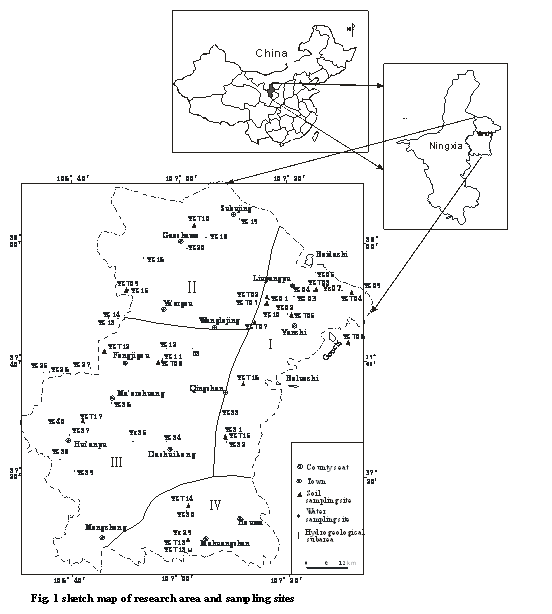
According to the aquifer’s characteristics, the groundwater system in Yanchi area can be divided to 4 groundwater subareas (Fig. 1): (i) the Quarternary and Cretaceous groundwater subarea in the east of the north oriented watershed. Groundwater flow east from the north oriented watershed to the salt lakes, Tertiary layers are scarce in this subarea, Quarternary groundwater can penetrate into cretaceous sandstone directly, form the abundant and good quality Cretaceous fissure-pore water;(ii) the archaic xitian river valley subarea. The river is in the north west of the research area, bounded by north oriented watershed in the east and the west oriented area in the south. it is disappeared now, groundwater mainly deposited in thicker part of the ancient valley, the distribution of groundwater of this subarea is like lenses along the river valley, the water quality in this subarea is changed abruptly from one aquifer lens to the other; (ⅲ) the southwest groundwater subarea, the thickness of Quarternary layers in this subarea is about 1~2m; Tertiary mudstone, as the bottom aquifuge for Quarternary groundwater, prevented the infiltration of shallow Quarternary groundwater, resulted in the lack of deep groundwater, and the poor quality of Quarternary groundwater; (ⅳ) the loess hills subarea in the south. The thickness of loess layer is about 60~150m in this subarea, for most rainwater has run off as floods, groundwater in the loess hills is scarce, only in the sites where the layer bellow the loess is Tertiary mudstone, small quantity of groundwater perch in the bottom of loess layer.
3. Material and
Methods
Soil samples were
collected from different typical landscapes and different layers in Yanchi
area, including weathered layer of Tertiary mudstone, Quarternary alluvial
deposits, lacustrine deposits, wind deposited sand and loess.
Rock samples were
collected from the drill cores of two hydrgeological boreholes.
The soil and rock
samples were air-dried and comminuted, grained by 50 mesh sieve (0.3mm aperture).
A total of 27 rock
samples and 18 soil samples were collected, at the same time, water samples
from shallow and deep groundwater were also collected around the sampling sites
in order to examine the relationship between fluoride in soils and in
groundwater, Fig. 1 shows the location of sampling sites.
Soil leaching
experiments were conducted at normal temperature in columns packed with different
soils. Each experimental soil column was kept at 60-cm depth with 1200-1750g of soil depending on different
soil gravitation capacity. A 2 cm water level maintained on the top
of column in order to keep the leaching speed. The experiments lasted for about
10 months.
Rock leaching
experiments were conducted in 500mL glass jars at a constant temperature of 15℃, to simulate the condition underground. In
each jar 100mL de-ionized water and 10 g 50 mesh grained rock powder
were put in, and the F contents of water were measured every other day, by ion
chromatogram method, one month later, the time intervals changed to once a week
or two weeks.
Total fluoride in
soils and rocks were analyzed by a fluoride ion selective electrode after
digestion of the weighed sample with NaOH.
The common
chemical composition (K, Na, Ca, Mg, Cl, SO4, HCO3) and F
of soil solutions were analyzed by titration method and ion chromatogram, after
mix with de-ionized water (ratio of soil to de-ionized water = 1:5), shake for
3 minutes, and filtrated. The pH of soil solution was measured by a pH meter.
The soil texture
was measured by sifting method and densimeter method. The heavy minerals
content of soil were measured by elutriation at first, and then separate the
different minerals by microscope. All these analytical procedures are
documented.
4. Results and
Discussion
4.1 Physical,
chemical characteristics and F content of soils
Table 1 shows the
texture, contents of F- bearing minerals, total F content (TF),
water soluble F content (WF), the total F leaching out (LF) in the 10 months
experiment, and the F content in the groundwater(GF) near the sampling sites.
In all the soil samples, wind deposited sands have the coarsest texture and
about the lowest TF and WF; weathered Tertiary mudstone has the finest texture
and the highest value of TF and WF. Among the F-bearing minerals, almost all
the hornblende and apatite is less than 1% and fluorite is absent, only mica is
abundant in some samples. All the soil samples are alkalescent, the pH of these
samples is around 8.07~10.05.
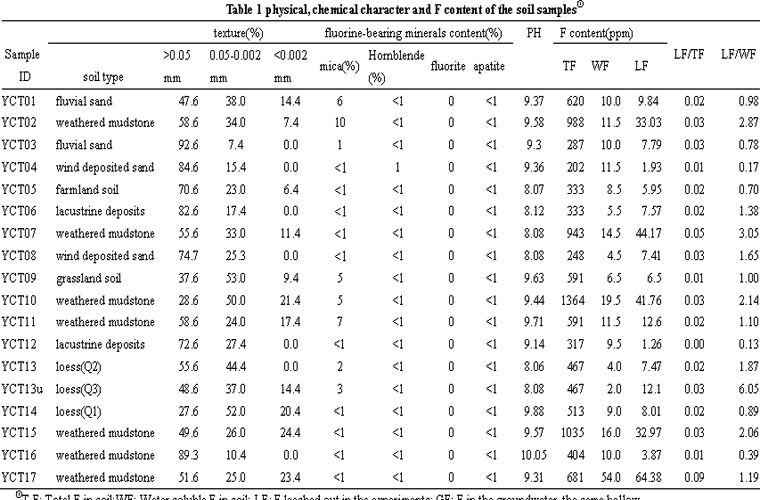
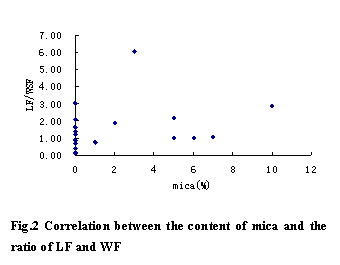


The value of LF and WF are similar to some extent,
apparently the main composition of LF is WF, when the LF value is smaller than
WF, it’s for the reason that leaching process of this soil is stagnant, WF
hasn’t been leached out thoroughly. But when LF is larger than WF, which kind
of F also leached out in the process? In view of that LF value has direct
influence on F content of groundwater, this other source of fluoride is also
very important to the F content of groundwater. The modality of fluorine in soil
can be classified into five species: water soluble fluoride (WF) ,
exchangeable fluoride ( Ex-F) , fluoride
bound to Fe/ Mn oxides ( Fe/ Mn-F) , bound to
organic matter (Or-F) , and residual
fluoride (Residual-F), (Wu Weihong et al. 2002; Jia Chenzhong et
al. 2005). In the measurement of
water soluble F, only the water soluble species can be leached out, but during
the leaching experiment, part of the other species can also be leached out,
thus result in the high value of F contents in leachates in comparison with the
water soluble F. But which species will contribute the most? Among the
F-bearing minerals, only mica has a measurable content, according to the
correlation figure of the content of mica and the ratio
between LF and WF (Fig.2), when the content of mica is low, the LF/WF value
change in an extent range, from 0.13~3.05, but when the content of mica is higher than 1%,
almost all the LF/WF values are larger than 1. That suggests fluoride in mica (part of the residual
modality) contributed considerably volume to the LF, but there are still other
forms of fluoride (such as Ex-F, Fe/Mn-F, Or-F, or other residual F species)
leached out in the 10 months.
The TF values of
Quarternary deposits are similar with the nationwide median value of TF in soil
(453ppm, Chinese Station of Environment Monitoring. 1990), but the WF
values are much higher than that of low fluoride area, such as Zhejiang(0.12ppm~1.72ppm, average 0.52ppm, by Wu Weihong, et
al. 2002). This suggests the high value of WF is maybe the main reason for the
high value of GF in Yanchi area, the high positive correlation between LF and
WF (0.805, as shown in Fig.3) also suggests this viewpoint.
In another aspect, TF values also have positive correlation with the LF, according to the statistic results of 17 samples, the correlation coefficient between TF and LF is 0.746 (shown in Fig.4), that suggests the soils with high value of TF have the tendency of leaching out much fluoride.
GF has no distinct relation with the WF, LF and TF, for
the fluoride leached out from the soils is only a small part of all the
fluoride recharging into the groundwater, except for the leaching process,
there are still other factors influencing the F content of groundwater.
The F leaching curve of
soils are shown in Fig. 5, different soils have different leaching speed of
fluoride, but the shapes of the leaching curves are similar, in the initial
time, the leaching speeds are very high, about one month later, it will slow
down. That means, in the initial time of leaching, it’s mainly the water
soluble F that leaching out, when the experiments going on, residual water
soluble F will leaching out slow and slow, and maybe some other forms of F also
leach out slowly.

4.2 Leaching
characteristics of rocks
The geological time of these rocks belong to Tertiary,
Cretaceous, and Jurassic, their lithologies are mudstone, sand stone and
gypsum.
|
|
The total F in rocks and
the total F leached out during the experiments are shown in table 2. The total
F in Tertiary, part of Cretaceous and Jurassic layer is higher than other
parts. Especially in part of the mudstone of Jurassic, its total F content is
2361ppm, 3~10 times to the F
content of tertiary and cretaceous layer. The total F contents in mudstones and
their leachates are higher than those in sandstone; the gypsum in tertiary
layer has about the same total F content in rock and leachate with sandstone.
The total F
leaching out from these rocks is significantly correlated positively with the
total F content; their correlation coefficient is 0.885, it’s large than that
of soils, that means the rocks with large value of TF are more liable to leach
out much fluoride to the groundwater.
The leaching curve
of F in rocks is as Fig. 6. The
shapes of the leaching curves are similar, in the first month, the F
concentration in the leachate reached a higher level quickly, in the following
dates, the F concentration in leachate rise slowly, and reached a constant
value in 6 months.
From the shape of the leaching curve we can induce, it’s
mainly the WF that leaching out in the experiment, maybe other modalities of F
can also be leached out, but there are not main compositions of the LF.
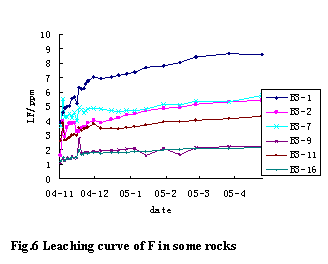
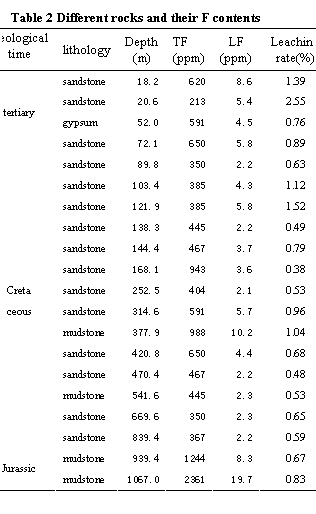
4.3The influences
of leaching characteristics of F in soils and rocks on the F content of
groundwater
According to the
results of analysis on the total F and water soluble F, and the leaching
experiments, the soils and rocks that have high TF value stand a good chance
have high WF value, and also can leach out much fluoride. That means the
stratum with high total fluorine will contribute much to the fluoride in
groundwater, these stratum includes the Tertiary mudstone, Jurassic mudstone, and
some of the cretaceous mudstone. But the most significant stratum influencing
the F content of groundwater is obviously the Tertiary mudstone, for it is
distributed ubiquitously, can leaching out large amount of fluoride, the
average of the LF value of the weathered Tertiary mudstone samples is 33.25
ppm, much more than that of the other soils. Jurassic stratum also has a high
TF value and a high WF value, but it lies beneath the Tertiary layer, and there
isn’t too much groundwater in it, so it can’t influence the groundwater quality
too much.
The texture of
soil and rock also influence their F content and leaching characteristics, soil
and rock with fine texture tend to have high value of TF and LF, such as the
mudstone of Tertiary; and soil and rock with coarse texture tend to have low
value of TF and LF, and have the most possibility of bearing groundwater with
good quality, such as the sandstone of Cretaceous and wind deposited sand.
OH- has
similar chemical characteristics with F-, and can exchange with the
exchangeable F and the F fixed in the crystal lattice of F-bearing minerals, thus high value of pH will
active the F in soil into water (Gunnar Jacks et al. 2005;
Baoshan Zheng. 1992). The alkalescent geochemical environment in Yanchi area
provided a perfect condition for the activation of fluoride, then lead to the
high fluoride content in groundwater. Furthermore, soil has vast buffering
capacity of OH-, the pH of soil can’t change drastically even
leached by litmusless water (Fig.7).

5 Conclusion
Wind deposited sands have the coarsest texture and about
the lowest TF and WF; weathered Tertiary mudstone has the finest texture and
the highest value of TF and WF. So the groundwater in wind deposited sands tend
to have good quality, and that in Tertiary mudstone possibly have bad quality.
Among the F-bearing minerals, only mica is abundant in
some samples, and it can contribute to the LF value to some extent.
All the soil samples are alkalescent, the pH of these
samples is around 8.07~10.05, and it
can’t change drastically, that provided a perfect environment for the activate
and migration of fluoride.
The TF values of
Quarternary deposits are similar with the nationwide median value of TF in
soil, but the WF values are much higher than that of low fluoride area, and it
is one of the main reasons for the high value of fluoride content in the
groundwater of Yanchi area.
The total F
content in Tertiary, Jurassic and some Cretaceous layers are higher than
national median value, and the LF have positive correlation with the TF of
them, that means lots amount of fluoride in these stratum can be leached into
groundwater.
Tertiary stratum
is a significant factor influencing the F content of research area, for it’s
ubiquitously distributed, and has high TF value and LF value.
Some of the
Jurassic mudstone contain lots of fluoride, and a considerable part of it can
be leached out(0.67%~0.83%); But for
it’s buried in depth, it can’t influence the water quality drastically.
For lots of
factors can influence the fluoride content of groundwater, the relationship
between the LF and WF of soil and the fluoride content of groundwater related
with the soil is not distinct, but obviously the overall high values of TF, WF
and LF is a key factor of the formation of high fluoride groundwater.
Acknowledgements
The work was financed by the project founded by the
Institute of Hydrogeology and Environmental Geology, Chinese Academy of
Geosciences ( Grant no: SK200303); We would like to thank Yu Qiusheng, Xue Zhongqi,
and Yu Yanqing for their warmhearted help and suggestions.
References
[1] Baoshan Zheng,
Daishe Wu, Binbin Wang, Xiaojing Liu, Mingshi Wang, et al. 2005. The main
geochemical process leading to the prevalent of endemic fluorosis. China Journal
of Endemic. 24(4):468~471.
[2] Baoshan Zheng,et
al. 1992. Research on the endemic fluorosis and industrial fluoride pollution. Beijing: China Environmental
Science Press. 88~135(in Chinese).
[3] Changhan Liu.
1988. Guidebook for endemic fluorosis prevention and cure. Beijing:
People’s Medical Publishing House.(in Chinese).
[4] Chinese Station of
Environment Monitoring. 1990. Background Value of Elements in the Soils of China. Beijing:
Chinese Environmental Science Press. (in Chinese).
[5] Gunnar Jacks,
Prosun Bhattacharya, Vikas Chaudhary, K.P. Singh. 2005. Controls on the genesis
of some high-fluoride groundwaters in India, Applied Geochemistry
20:221–228;
[6] Jia Chenzhong , Li
Kehua, Qin Qiaoyan, Fan Shengcai, Xu Yan. 2005. Research on the different
modality of fluorine in the soil near thermal power station. 19(2): 120~126.
[7] Junyao Yang. 2000.
The Study on Dynamic Characteristics of Fluoride Migration in Unsaturated Soil,
Journal of Taiyuan university of technology. 31(2):107~109.
[8] Lisheng, Yang,
Peter J. Peterson, W. Peterwilliams, Wuyi Wang, Ribang Li, and Jian’an Tan.
2003. Developing environmental health indicators as policy tools for endemic
fluorosis management in the People’s Republic of China. Environmental
Geochemistry and Health. 25: 281–295.
[9] Wang Genxu, Cheng
Guodong. 2001. Fluoride distribution in water and the governing factors of
environment in arid north-west China. Journal of Arid Environments. 49:
601–614.
[10] Wang Lian-Fang and
Huang Jian-Zhong. 2000. Outline of control practice of endemic fluorosis in China.
Social Science & Medicine. 41(8):1191-1195.
[11] Wu Weihong , Xie
Zhengmiao1, Xu Jianming, Hong Ziping, Liu Chao. 2002. Characteristics
of Forms of Fluorine in Soils and Influential Factors, environmental science. 23(2):
104~108.
[12] Wuyi Wang, Ribang
Li, Jian’an Tan, Kunli Luo, Lisheng Yang, Hairong Li, Yonghua Li. 2002.
Adsorption and leaching of fluoride in soils of China. Fluoride. 35(2):
122-129.




